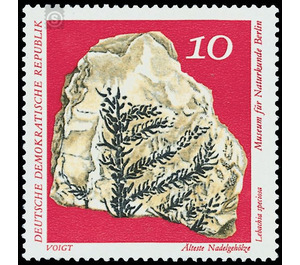Paleontological collections from the Museum of Natural History in Berlin - Germany / German Democratic Republic 1973 - 10 Pfennig
Theme: Architecture
| Country | Germany / German Democratic Republic |
| Issue Date | 1973 |
| Face Value | 10.00 |
| Color | brown red |
| Perforation | K 13 |
| Printing Type | Photogravure |
| Stamp Type | Postage stamp |
| Item Type | Stamp |
| Chronological Issue Number | 1564 |
| Chronological Chapter | GER-DDR |
| SID | 994709 |
| In 33 Wishlists | |
Paleontological collections from the Museum of Natural History in Berlin The Ministry of Posts and Telecommunications of the German Democratic Republic publishes six multicolored special postage stamps depicting motifs of paleontological collections from the Museum of Natural History in Berlin. Paleontological collections from the Museum of Natural History Berlin The fossils from the paleontological collections of the Museum of Natural History Berlin on the special stamps are particularly valuable original witnesses of the history of life on earth. They are both research objects and simultaneously used illustrative material in the educational work of the museum. The Museum of Natural History Berlin - an institution of the Humboldt University - preserves, maintains and extends, among other natural history collections, the largest paleontological collection of the GDR with about 15 million objects. 10 Pfennig value: Oldest coniferous plants, Lebachia speciosa; FLORIN The oldest conifers in the history of the earth occur about 280 million years ago, at the turn of Carboniferous Perm. Together with the oldest ginkgo and cycad plants, they embody the element of the new within the old (paldophytic) flora. Our motif shows a branch of Lebachia speciosa from the lower Permian of the Saar-trough. These oldest conifers were small trees growing outside the moors, with whorls of main branches and separate-sexed cones at the ends of the lateral branches.


